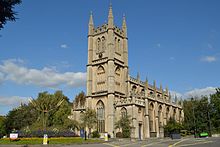St Mary the Virgin's Church, Bathwick
| St Mary the Virgin's Church | |
|---|---|
 | |
 | |
| 51°23′3″N 2°21′4″W / 51.38417°N 2.35111°W | |
| Country | United Kingdom |
| Denomination | Church of England |
| Churchmanship | Anglo-Catholic |
The Church of St Mary the Virgin is located on Church Street (not Raby Place as Pevsner mentions, although the two are the same street) in the Bathwick area of Bath, Somerset, England. The church is Anglican and located near Pinch's Sydney Place (1808) and Bath's famed Sydney Pleasure Gardens.
The church was constructed by the Pulteney family, who used it to replace the medieval parish church of St Mary's, Bathwick, known even in Georgian times as Bathwick Old Church. The churchyard is now part of Smallcombe Cemetery.
The Church of St Mary the Virgin was where the band Muse recorded the organ parts on their second studio album Origin of Symmetry.[1]
Pevsner's description
"St Mary [the Virgin], Raby Place, Bathwick. 1814–20 by Pinch (John Pinch the Elder). The chancel by G.E. Street, 1873–5. Meant to be in the Somerset Gothic style, though of course the result is typical of early C19. W tower with pierced parapet and polygonal pinnacles. Nave, aisles, clerestory, high and a little pinched. Perp[endicular] tracery in the tall aisle windows and the lower clerestory windows with thin four-centered heads. Very tall thin piers of standard Somerset section (four hollows). Three galleries. No arcade arches, but a flat timber lintel running through. This was originally plastered. Ribbed coved ceiling. The chancel not of particular interest. – PAINTING. On the altar early C16 polyptych, four winds, Netherlandish. – The original altar painting, an Adoration of the Child by Benjamin Barker, hangs high up against the W wall. – PLATE. Chalice and Cover 1572; Paten by Fawdery 1723; Chalice and Paten 1837."
Music
The organ in St. Mary's is the only example in the city of the work of Father Henry Willis. The musical tradition of the church dates back to the late 1800s when the Oxford Movement's influence caused the establishment of a robed choir. For many years the reputation of the church choir rode high but during the 1970s and 1980s it proved difficult to maintain the numbers of boy trebles, prompting the formation of an all-adult choir. In the 1990s and into the new millennium the standards once again rose, and the choir of St. Mary's came to be held in high regard, making several recital tours within the UK and abroad, and broadcasting on radio and television.[2]
See also
External links
- "Church of St Mary, Bathwick Hill". Images of England. Archived from the original on 7 October 2012. Retrieved 15 April 2008.
References
- ^ "Muse – Origin of Symmetry". Discogs. Retrieved 1 July 2008.
- ^ "The Choir of St. Mary's, Bathwick". Bathwick parishes. Retrieved 5 May 2018.
- Nikolaus Pevsner (1958). The Buildings of England: North Somerset and Bristol. Harmondsworth: Penguin Books, 106–107.
